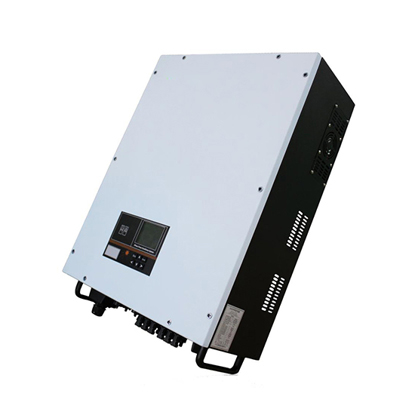The growing emphasis on renewable energy has led to significant advancements in technology, particularly in solar power systems. A key component of these systems is the on-grid inverter, which plays a crucial role in converting the direct current (DC) generated by solar panels into alternating current (AC) that can be fed into the electrical grid. This article provides an in-depth overview of on-grid inverters.
What is on grid inverter?
It's an inverter used to convert DC "direct current" coming from solar panels or wind turbine to AC "alternating current" and injects into the power grid.
The on-grid inverter must match grid sine wave phase and voltage, so can inject the AC current into it. The most important feature of such inverter is its ability to work without batteries, it based on solar panels or wind turbine and power grid presence only, so if the solar energy or wind energy are not sufficient to feed the load, it consumes his power requirements from the power grid.
Grid on inverters synchronize the phase and frequency of the converted AC electricity with the grid's AC signal. This synchronization is crucial to ensure that the power from the solar panels can be seamlessly integrated into the existing electrical infrastructure. When the solar power system generates more electricity than the household consumes, the excess energy is fed back into the grid.
Solar grid tie inverters are preferred in areas with reliable utility grids because they do not require batteries for energy storage, reducing costs and maintenance. However, they do not provide power during grid outages, unless combined with a battery backup system or specific configurations that allow for limited off-grid functionality.
How does grid on inverter work?
Simply the inverter has a computer module that senses the grid AC voltage waveform and continuously measure all its parameters instantly like voltage, frequency…etc. and then starts to inject the AC current, so that the inverter keeps its output voltage to be slightly higher than grid voltage all the time.
In the same time, the grid connected inverter must have anti islanding feature which quickly disconnect it if the grid power system shuts down for any reasons, so protect itself from feeding uncontrollable loads "may be higher capacity" and protect personnel who were sent to troubleshot the power grid.
- DC to AC Conversion. The inverter converts the DC electricity produced by the solar panels into AC electricity, matching the voltage and frequency of the grid.
- Synchronization with Grid. It ensures that the output AC power is synchronized with the grid's voltage, frequency, and phase. This is crucial for safe and efficient power integration into the grid.
- Maximum Power Point Tracking (MPPT). The inverter uses MPPT algorithms to maximize the power output from the solar panels by continuously adjusting the electrical operating point of the modules.
- Safety Features. It includes safety mechanisms like anti-islanding protection, which shuts down the inverter if the grid goes down to prevent back-feeding power, protecting utility workers and the system itself.
- Monitoring and Communication. Modern inverters often have monitoring systems to track performance, providing real-time data on power production and efficiency.
What are grid connected inverter types?

There are 3 types of inverters in the market:
- Low frequency with transformer coupling inverter.
- High frequency with transformer coupling inverter.
- Transformer-less inverter.
For the first and second type, the inverter has a transformer inside and a computer unit which schedule converting the DC power to low or high frequency and return to DC power again, then converting to final AC voltage which matches the power grid. Inverter.com offers 300W to 1000W grid tie inverters and 300W to 1400W micro solar inverters with transformer design.
For transformer-less inverter, it doesn't have transformer inside, so it converts DC to AC with high converting efficiency. Although the price of transformer type inverter is lesser than transformer-less type, but transformer-less inverter is smaller, lighter and more efficient.
One thing pertaining to transformer-less type is, it doesn't have a transformer inside, so there will be concerns about the absence of galvanic isolation between DC side and AC side, so the probability of injecting dangerous DC currents and voltages into the power grid.
Which on grid inverter type you should purchase?
We recommend to buy the most advanced and efficient transformer-less type, single phase 1500W to 10kW and three phase up to 50kW transformer-less on grid solar inverters are available here. Just check their specs in regard to DC voltage and current components injections, to be sure its within safety limits.
At the same time, when selecting a solar grid connected inverter, several factors need consideration. Firstly, assess your energy needs and the size of your solar panel system to ensure compatibility. Look for inverters with high efficiency ratings to maximize energy conversion from DC to AC power, ultimately optimizing your system's performance. Consider the inverter's reliability, warranty, and manufacturer reputation for long-term support and service. Additionally, prioritize inverters with advanced monitoring and data logging capabilities to track energy production and system health effectively.
On grid tie inverters are a pivotal component of solar power systems, enabling the seamless integration of renewable energy into the electrical grid. Their ability to convert DC to AC, synchronize with the grid, and optimize energy harvest through MPPT makes them indispensable in modern solar installations. As technology continues to advance, on-grid inverters are becoming more efficient, reliable, and versatile, paving the way for a more sustainable energy future. A wide range of on grid power inverters are available in Inverter Shop. Whether for residential or commercial applications, the benefits of on-grid inverters are clear: cost efficiency, high performance, scalability, and vital support for grid stability. With ongoing innovations, the role of on-grid inverters in the renewable energy landscape is set to become even more significant.
